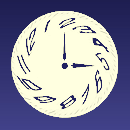

NOTE - Oct 2019 - NIH has finally (after 7 years!!) added a page on Circadian Rhythm Disorders. No need for additional letters.
NIH has not included DSPD or Non-24 on their website!
The U.S. National Institutes of Health (NIH) has a number of web pages which talk about sleep disorders. In all these pages we see sleep apnea, narcolepsy, and restless legs; but we do not see any Circadian Rhythm Sleep Disorders - no Delayed Sleep Phase Disorder, no Non-24-Hour Sleep-Wake Disorder. It's no wonder people haven't heard of these disorders, and many doctors still don't recognize how serious they are.
Circadian sleep disorders still are not included:
We have asked the NCSDR (National Center on Sleep Disorders Research, part of NIH) several times to add these disorders. We have been told by them that they have requested this change, but funding is scarce and these changes haven't been made. We hope that some public pressure will speed a resolution. Please send email to NIH in support of this.
You may use the sample email message below - just copy and paste it into your own email. Remember to add your name and city/state/zip in the body. See the step by step instructions below.
It may be more persuasive if you add a personal sentence or two at the top of the message body, or better yet, rewrite that section to reflect your own personal experiences. But most important is to send something.
Only if that link did not open a new email with the headers filled out, you'll have to do so manually:
| To: | twerym@nhlbi.nih.gov |
| Cc: | csd-n-news@csd-n.org |
| Subject: | Please Add Circadian Rhythm Sleep Disorders To Your Website |
| Body: |
Please Add Circadian Rhythm Sleep Disorders To Your Website
Delayed Sleep Phase Disorder is estimated to affect 500,000 American adults. The adolescent version, which can resolve during early adulthood, has been estimated to affect as many as 2,000,000 teens. Non-24-Hour Sleep-Wake Disorder is estimated to affect perhaps 90,000 Americans, both blind and sighted. These numbers probably underestimate the number of people with circadian disorders. Compare this with the incidence of narcolepsy of about 150,000, which is documented on the NIH website. Clearly, not including Circadian Rhythm Sleep Disorders is a major omission. Sleep deprivation has been shown to increase the risk of cancer, heart disease, diabetes, and other chronic illnesses. Many people are pushing themselves into sleep deprivation because the public and even many in the medical community do not understand the full impact of circadian rhythms on sleep. People come to the NIH website looking for guidance and information. Your coverage of these major disorders would help us to obtain proper treatment, accommodations, and respect. Lack of inclusion on the NIH website suggests that these disorders need not be taken seriously. And since other health websites look to the NIH site for guidance on what to cover, this creates a multiplier effect. We suffer twice: once from the disorder itself, and again because people are unaware of these disorders and don't take them seriously. Even many doctors do not recognize these as valid disorders. And we cannot point the doctors to the respected NIH website, because NIH doesn't recognize us there either. NIH, you are part of the problem! Please - add these Circadian Rhythm Sleep Disorders to the appropriate NIH web pages. And please add Circadian Sleep Disorders Network (www.circadiansleepdisorders.org) to your list of NCSDR Participating Organizations (www.nhlbi.nih.gov/about/ncsdr/patpub/patpub4.htm). Thank you. Sincerely, <your name> <your city, state or province or country, zip> |
Set up the email. (if your email program supports this)
Remember to enter your name and your city, state (US) or province (Canada) or country, and postal code at the bottom of the email.
Thank you for helping our campaign to get NIH to post Circadian Sleep Disorders information on their website.